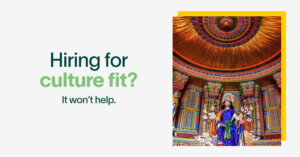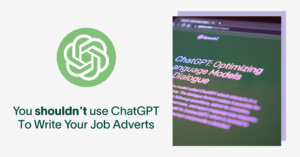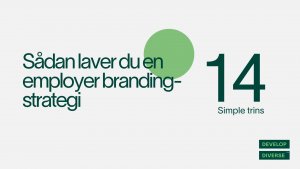When you’re trying to build a more diverse and inclusive organisation, it’s often tempting to start with recruiting for where your biggest representation gaps are. But recruiting to improve your workforce composition can be a slow process — especially if you’re struggling to reach the right groups of candidates through your usual channels.
And while it may seem completely logical to speed this process by writing a job advert that appeals specifically to the identity group you’d like to hire from, ultimately, it won’t work — either to attract your ideal candidate or increase your organisation’s diversity.
In this post, Emil Novák-Tót, our Head of Research, explains what targeted language is, who it impacts, and how it can negatively impact your recruitment outcomes.
What is targeted language?
“Targeted language is a way of limiting our language choices to make them more appealing to specific groups of people,” Emil explains. “If we take gender as an example, while it may seem logical that using more communal, or ‘feminine-coded’, language in a job advert might help you attract more women, it’s unlikely to work — and it could even backfire. This is because it actually ends up reinforcing stereotypes and bias.
“We’ve seen evidence of this in our own research — inclusive language is a far stronger predictor of men and women’s likelihood of applying to a role over communal language or agentic (masculine-coded) language.”
Targeted language can be conscious or unconscious, but in both cases, it can signal to your candidates that your organisation might not be an inclusive place to work.
In a job advert, language can communicate that when you’re looking for someone helpful and friendly, you really mean that you’re looking for a woman. Targeted language can be a red flag to a person on the autism spectrum that your software engineering job will consist of repetitive tasks based on a stereotypical understanding of their abilities, rather than a varied role with opportunities for growth.
When we use targeted language designed to ‘speak’ to one group of people above all others, it doesn’t mean we’re being more inclusive to that one group. Instead, it means we’re using language based on a stereotypical assumption of how that person wants to be spoken to. That means we’re already starting from a point of bias, rather than inclusion. And it goes far beyond just gender.
“A great example of this is if an organisation is trying to attract a younger workforce, or younger customer — so they change their language to appeal to that audience,” Emil explains. “It also goes the other way: If you’re trying to target older candidates, and you mention a slower pace, stability, and mentoring opportunities. In reality, both are going to come off insincere, and both are more likely to have the opposite effect to what you intended.”
Where does targeted language show up?
In a typical job advert, targeted language can be found in the desired traits of your candidate, the role description, responsibilities, and the words you choose to describe your culture or organisation.
Many of these language choices can happen at an unconscious level — especially if they’re reinforced by a mental picture of who the ‘ideal’ candidate is. In a job advert for a nurse, for example, societal biases mean we’re more likely to picture a woman.
This means that whether you’re discussing your mission-driven culture or your free childcare facilities, you need to be conscious as to how all the words you choose to describe a role may communicate implicit stereotypes or bias. You also need to consider how they might be interpreted by members of different identity groups.
If you’re hiring for both a product manager and an executive assistant for example, you’ll want to make sure you don’t only mention your free childcare facilities in the job advert for the executive assistant.
Targeted language can also show up in more explicit ways, like your organisation’s diversity statement, or explicit statements on your recruitment page that relate to your employer branding.
“Research shows that when we’re looking at explicitly targeted language, like employer equal opportunity statements, they can have a very varied effect on different groups. For example, one study found that Black people were actually discouraged from applying to organisations after reading their equal opportunity statement, because they felt like they would be hired for tokenistic reasons, rather than based on their own merit.”
What is the impact of targeted language?
While creating job adverts targeted towards specific groups of people might seem like a no-brainer when trying to increase your organisation’s level of diversity, it actually can have a huge impact on not only who applies to the role, but a number of important outcomes downstream, too.
“It can change almost everything from who is invited to the interview, to how people are interviewed, and who gets the role,” Emil explains. “Before people even apply to the role, you’ve already primed yourself that you’ll hire a certain type of candidate. So if you’ve written a job advert that’s consciously or unconsciously targeting women for a role, you’re already starting your hiring process based on a stereotype of what you expect to see.
“But if the woman you interview does not match that stereotype — maybe she is focused on career advancement, for example — then you’re more likely to evaluate them negatively because they don’t fit into your unconscious selection process.”
It goes deeper than just who ends up in the interview room. Using targeted language in a job advert means you’re also less likely to be objective on the questions you ask, and how you score the candidate’s suitability. Ultimately, that changes who gets the job.
Eliminate targeted language, increase the diversity of your candidate pool
Building more diverse and inclusive organisations may start with language. But it doesn’t start with using language to target the types of people we want to see in our organisations in the future.
Instead, it starts with increasing the inclusivity of how we communicate. Research consistently shows that inclusive language benefits everyone — so when you’re able to identify and eliminate unconscious bias and stereotypes in your written communication, it means you can start building a company where everyone feels they can belong.
Develop Diverse is an inclusive communication platform that can help you get started on this journey. Our research-backed tool leverages AI and machine learning to help you identify biased language in your job adverts and beyond, suggesting the alternatives that build an inclusive employer brand and more diverse organisation. Book a demo with one of our team members today.





